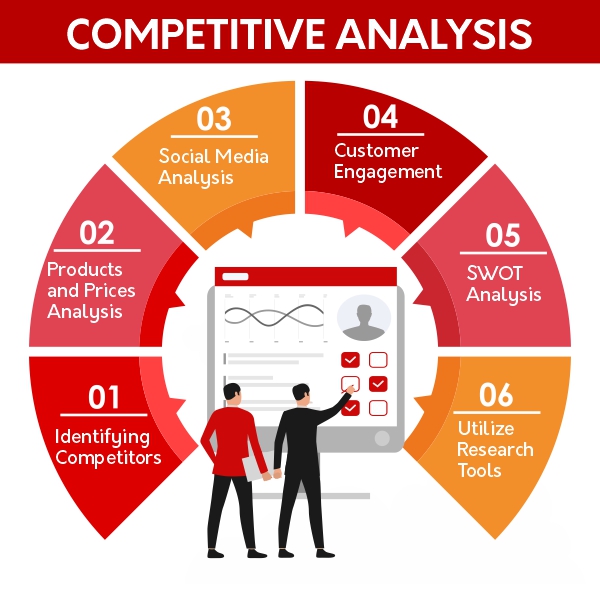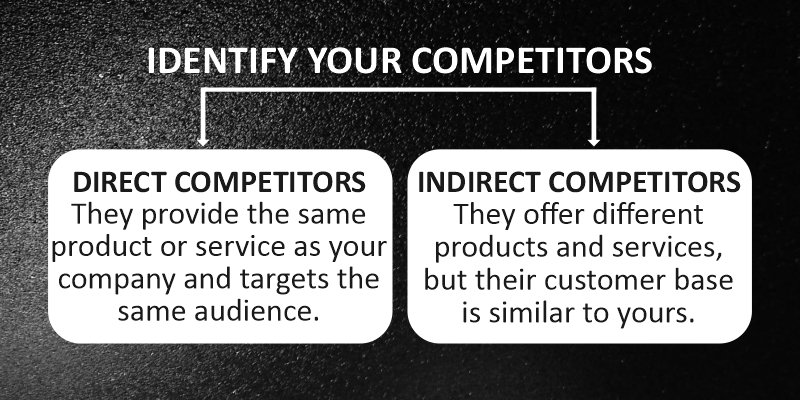
When your competitors are gaining ground on you and you can’t figure out why, it can be one of the most aggravating business circumstances.
Despite having high-quality products, responsive customer service, and incisive and informative marketing, you continue to observe your market share declining.
You can’t just idly look at your competitors and ask what they’re doing right to try to solve this mystery. You must employ a thorough strategy and produce a competitive analysis.
A competitive analysis assists you in evaluating your competitors’ strengths and weaknesses. You must understand how similar firms operate in order to know how responsive the market is to your business and what works best. Learn what errors to avoid and trends to incorporate into your own business.

Listed below are the six steps for conducting an effective competitive analysis:
The first stage of competitive analysis is to identify your competitors. There are two kinds of competitors: direct and indirect.

A direct competitor is one who provides the same product or service as your company and targets the same consumer base. An indirect competitor is one that sells similar items but targets a different consumer segment, or one that provides different products and services but has a similar customer base to you. Identifying and researching your indirect competitors is crucial since it provides a wider perspective on your company or consumer base.
You can find out your direct and indirect competitors by performing a simple online search or by using websites like Product Hunt and Crunchbase that help you carry out market research.
After you’ve found and grouped your competitors, evaluate their online presence by evaluating how effective their websites are, how simple it is to shop on their site, and how frequently they engage with their audience.
Most business make effective digital marketing and e-commerce strategies as a way to stand out against competition. Having user friendly website & engaging with consumers on social media platforms play an important role to make a good online presence.
Customer feedback on various platforms like Google, Yelp, and Facebook play an important role. You can inspect how they respond to their customers’ inquiries and online negative feedback.
Online reviews give insight into a company’s customer service. Reading negative reviews might help you understand where these firms went wrong and what you can do to avoid similar instances. Reading positive reviews also allows you to focus on areas where the company excelled and discover how you can provide even better customer service.
While reading online reviews and comments, make a note of people from whom you’d like to learn more. You can directly engage with them to understand their needs and the reasons behind their unpleasant experiences with your competitor.
In addition to learning about the consumer experience, you are directly interacting with them, which can generate future business.
Once you’ve completed all of your research, compile it in one place and evaluate the strengths and weaknesses of your competitors. Use this data to improve your own business and concentrate on certain areas where you can benefit.
Conducting a competitive analysis is critical to the growth of your business. However, it can be quite tiresome and time-consuming, especially if you’re looking at numerous competitors.
Fortunately, there are numerous internet research tools available to make the process easier and more effective. These tools can assist you in identifying competitors, tracking their content, and analysing the results. The most often used tools include BuzzSumo, SEMrush, SpyFu, and Owletter. Using research software saves you time while delivering the best results for your company.
What does it signify for your firm once a competitive analysis is finished? Now that you have a solid foundation, you can create more successful sales and marketing plans, identify fresh leads, and influence how people perceive your business.
A competitive analysis, however, is not a one-time procedure. You shouldn’t rely for too long on a single analysis that summarises the state of your competition because it isn’t constant and unchanging.
Regularly analyzing the competitive analysis and updating your analysis is a wise practice. You can make sure you always have an accurate picture of the businesses vying for your clients by putting the appropriate structures and tools in place. With the latest information, you’ll be able to act pro-actively and make the decisions that will help you dominate your market.
Authored by :- Guniyal Bagga
© Copyright 2024 – Wissen Research All Rights Reserved.